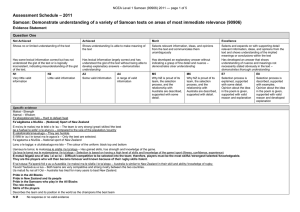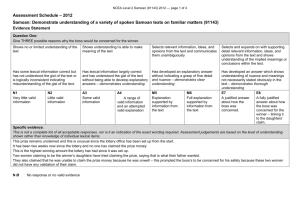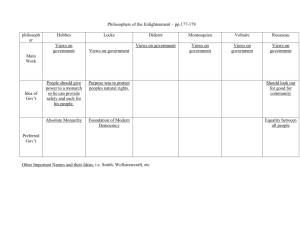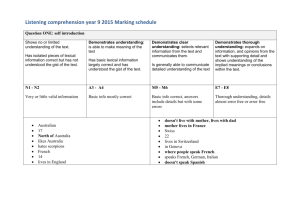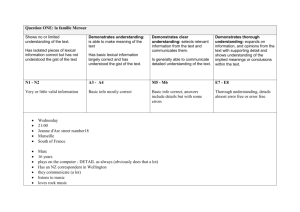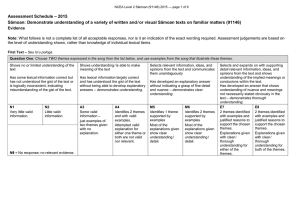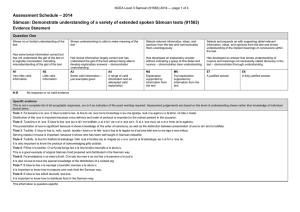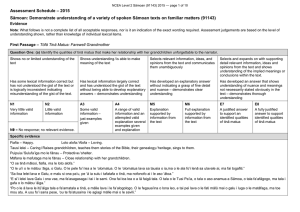– 2012 Assessment Schedule
advertisement
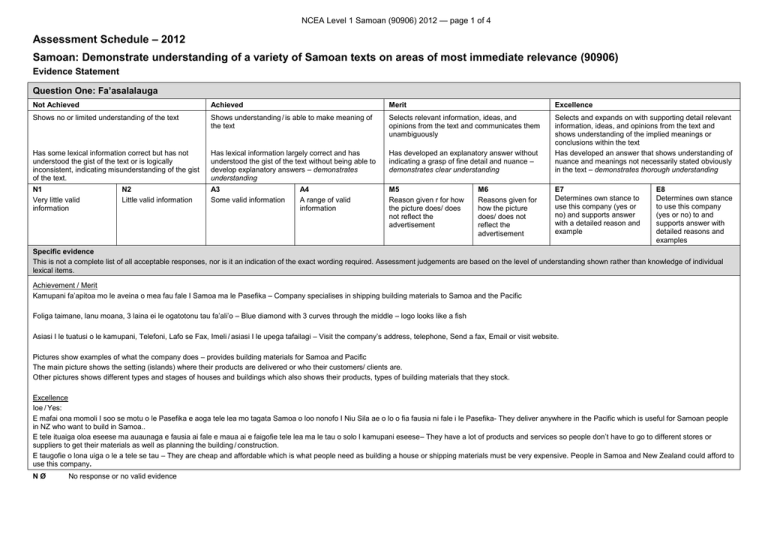
NCEA Level 1 Samoan (90906) 2012 — page 1 of 4 Assessment Schedule – 2012 Samoan: Demonstrate understanding of a variety of Samoan texts on areas of most immediate relevance (90906) Evidence Statement Question One: Fa’asalalauga Not Achieved Achieved Merit Excellence Shows no or limited understanding of the text Shows understanding / is able to make meaning of the text Selects relevant information, ideas, and opinions from the text and communicates them unambiguously Has some lexical information correct but has not understood the gist of the text or is logically inconsistent, indicating misunderstanding of the gist of the text. Has lexical information largely correct and has understood the gist of the text without being able to develop explanatory answers – demonstrates understanding Has developed an explanatory answer without indicating a grasp of fine detail and nuance – demonstrates clear understanding Selects and expands on with supporting detail relevant information, ideas, and opinions from the text and shows understanding of the implied meanings or conclusions within the text Has developed an answer that shows understanding of nuance and meanings not necessarily stated obviously in the text – demonstrates thorough understanding N1 Very little valid information A3 Some valid information M5 Reason given r for how the picture does/ does not reflect the advertisement N2 Little valid information A4 A range of valid information M6 Reasons given for how the picture does/ does not reflect the advertisement E7 Determines own stance to use this company (yes or no) and supports answer with a detailed reason and example E8 Determines own stance to use this company (yes or no) to and supports answer with detailed reasons and examples Specific evidence This is not a complete list of all acceptable responses, nor is it an indication of the exact wording required. Assessment judgements are based on the level of understanding shown rather than knowledge of individual lexical items. Achievement / Merit Kamupani fa’apitoa mo le aveina o mea fau fale I Samoa ma le Pasefika – Company specialises in shipping building materials to Samoa and the Pacific Foliga taimane, lanu moana, 3 laina ei le ogatotonu tau fa’ali’o – Blue diamond with 3 curves through the middle – logo looks like a fish Asiasi I le tuatusi o le kamupani, Telefoni, Lafo se Fax, Imeli / asiasi I le upega tafailagi – Visit the company’s address, telephone, Send a fax, Email or visit website. Pictures show examples of what the company does – provides building materials for Samoa and Pacific The main picture shows the setting (islands) where their products are delivered or who their customers/ clients are. Other pictures shows different types and stages of houses and buildings which also shows their products, types of building materials that they stock. Excellence Ioe / Yes: E mafai ona momoli I soo se motu o le Pasefika e aoga tele lea mo tagata Samoa o loo nonofo I Niu Sila ae o lo o fia fausia ni fale i le Pasefika- They deliver anywhere in the Pacific which is useful for Samoan people in NZ who want to build in Samoa.. E tele ituaiga oloa eseese ma auaunaga e fausia ai fale e maua ai e faigofie tele lea ma le tau o solo I kamupani eseese– They have a lot of products and services so people don’t have to go to different stores or suppliers to get their materials as well as planning the building / construction. E taugofie o lona uiga o le a tele se tau – They are cheap and affordable which is what people need as building a house or shipping materials must be very expensive. People in Samoa and New Zealand could afford to use this company. NØ No response or no valid evidence NCEA Level 1 Samoan (90906) 2012 — page 2 of 4 Question Two: O le Aso Sa Pa’epa’e Not Achieved Achieved Merit Excellence Shows no or limited understanding of the text Shows understanding / is able to make meaning of the text Selects relevant information, ideas, and opinions from the text and communicates them unambiguously Has some lexical information correct but has not understood the gist of the text or is logically inconsistent, indicating misunderstanding of the gist of the text. Has lexical information largely correct and has understood the gist of the text without being able to develop explanatory answers – demonstrates understanding Has developed an explanatory answer without indicating a grasp of fine detail and nuance – demonstrates clear understanding Selects and expands on with supporting detail relevant information, ideas, and opinions from the text and shows understanding of the implied meanings or conclusions within the text Has developed an answer that shows understanding of nuance and meanings not necessarily stated obviously in the text – demonstrates thorough understanding N1 Very little valid information A3 Some valid information M5 Explains their understanding of what happened at Patela’s shop. N2 Little valid information A4 A range of valid information M6 Explains their understanding of what happened at Patela’s shop mentioning Lagi’s defensive behaviour of her grand daugjhter E7 Identifies and explains in detail a quality that Lagi and the writer have in common E8 Identifies and explains in detail qualities that Lagi and the writer have in common Specific evidence This is not a complete list of all acceptable responses, nor is it an indication of the exact wording required. Assessment judgements are based on the level of understanding shown rather than knowledge of individual lexical items. Fai fa’atasi le tauloto ma se isi tamaitiiti po o se tagata matua – Recite their tauloto with another child or adult Fa’ata’ita’i i le fale po o I luma o tagata / fa’ata I le fale muamua ina ia masani – Practice in front of people / mirror at home first until they are confident Tu’u e fa’amulimuli le faiga o le tauloto – leave them for last in the order of doing their tauloto. The dress was very important because it was a beautiful dress that was prepared by grandmother and her mother which caused her to be sad. Excellence E matamumuli uma I la’ua/They are both shy: “Fai mai o ia e le fiafia foi pe a tautala i luma o tagata” E tutusa la’ua ma e malamalama lelei le isi I le isi. – Lagi understands her grand daughter because they are similar which is why they are very close. It could also explain why the writer is so sad that she isn’t able to make her grandmother proud and say her tauloto. Ina o i ai i le faleoloa ua ita Lagi aua ua vaai atu ua leva ona fa’atali lana tama mo se aisakulimi ae e le o amana’ia e le fa’atau’oloa. Alu atu loa Lagi otegia le fa’atau’oloa ma ua le mana’o e fa’atau ni aisakulimi. O aga ia o Lagi ona ua ia alofa i lana tama I le matamuli o le tusitala ua ala ai ona le amana’ia e le fa’atau’oloa. Pala’ai/ Fefe/ Matamuli - Stage fright/ frightened/ nervous Some children are too young to understand what is happening and are overwhelmed by the many people watching and so are not able to remember their lines. NØ No response or no valid evidence NCEA Level 1 Samoan (90906) 2012 — page 3 of 4 Question Three: O le Komepiuta e iloa fo’i fa’asamoa Not Achieved Achieved Merit Excellence Shows no or limited understanding of the text Shows understanding / is able to make meaning of the text Selects relevant information, ideas, and opinions from the text and communicates them unambiguously Has some lexical information correct but has not understood the gist of the text or is logically inconsistent, indicating misunderstanding of the gist of the text. Has lexical information largely correct and has understood the gist of the text without being able to develop explanatory answers – demonstrates understanding Has developed an explanatory answer without indicating a grasp of fine detail and nuance – demonstrates clear understanding Selects and expands on with supporting detail relevant information, ideas, and opinions from the text and shows understanding of the implied meanings or conclusions within the text Has developed an answer that shows understanding of nuance and meanings not necessarily stated obviously in the text – demonstrates thorough understanding N1 Very little valid information A3 Some valid information M5 A wide range of valid information including where to buy food. An opinion about walking to school given, supported with a reason N2 Little valid information A4 A range of valid information describing writer’s feelings about new school M6 A wide range of valid information including where to buy food. An opinion about walking to school given, supported with reasons E7 Support or does not support the writer going to extra English classes. Answer is supported with detailed reason/ justification E8 Support or does not support the writer going to extra English classes. Answers are supported with detailed reasons/ justification Specific evidence This is not a complete list of all acceptable responses, nor is it an indication of the exact wording required. Assessment judgements are based on the level of understanding shown rather than knowledge of individual lexical items. Achievement / Merit The writer is happy, likes school, likes the teachers who care and help him, Likes the subjects Goes twice a week to classes that extra English classes, He tries to learn new things, He always asks the teacher/ students to repeat themselves and speak slowly Excellence Ioe/ Yes This will help the writer to communicate better with the teachers and other students especially because he finds that they speak too fast and because as he said everyone speaks in English. He will also be able to cope/ understand not only English but also other subjects as all of the subjects are taught in English. This may lead to him achieving well in all of his subjects, which is probably why he is now living in New Zealand in order to succeed at school. NØ No response or no valid evidence NCEA Level 1 Samoan (90906) 2012 — page 4 of 4 Question Four: O la’u Gagana Not Achieved Achieved Merit Excellence Shows no or limited understanding of the text Shows understanding / is able to make meaning of the text Selects relevant information, ideas, and opinions from the text and communicates them unambiguously Has some lexical information correct but has not understood the gist of the text or is logically inconsistent, indicating misunderstanding of the gist of the text. Has lexical information largely correct and has understood the gist of the text without being able to develop explanatory answers – demonstrates understanding Has developed an explanatory answer without indicating a grasp of fine detail and nuance – demonstrates clear understanding Selects and expands on with supporting detail relevant information, ideas, and opinions from the text and shows understanding of the implied meanings or conclusions within the text Has developed an answer that shows understanding of nuance and meanings not necessarily stated obviously in the text – demonstrates thorough understanding N1 Very little valid information A3 Some valid information M5 Attempts to discuss the connection between either the Bible verse, or the proverb with la’u gagana, however, answer lacks depth / detail N2 Little valid information A4 A range of valid reasons for young people not knowing the language M6 Attempts to answer the connection between both the Bible verse and the proverb with la’u gagana, however, answers lack depth / detail E7 Discusses in detail the connection between either the Bible verse and and la’u gagana, or the proverb and la’u gagana E8 Discusses in detail the connection between both the Bible verse and the proverb with la’u gagana Specific evidence This is not a complete list of all acceptable responses, nor is it an indication of the exact wording required. Assessment judgements are based on the level of understanding shown rather than knowledge of individual lexical items. Achievement Ona o le matanana, Fa’atamala o matua, Ua le lavava a’o le gagana po ua fiu ona o le fai so’o. Fuaiupu mai le Tusi Paia: “E sili le usita’i i lo le ga’o o le mamoe po’a” Merit / Excellence The Bible verse encourages young people to keep trying to learn the language and be disciplined and obey / follow their parents’ teachings / guidance in order to gain the reward of knowing your language. O le usita’I ua fa’atusaina lea I le faigata o le taumafai e a’o le gagana aua e tele taimi e fa’aosoosoina ai le tupulaga talavou e fa’apalagi ae le fa’asamoa. Ae afai e usita’I ma taumafai pea e a’o lau gagana, e fa’amanuiaina lou olaga e pei o le maua o se mea matagaofie e pei o le mamoe po’a. Afai e le usita’i ona toe salamo ifo lea ua tuai, ua le mafai ona toe malamalama I le gagana Samoa. O le feso’ot a’iga o le alagaupu ma la’u gagana, o le alagaupu o lo’o fa’amanatu pea I le tupulaga le taua o le a’oina o lau gagana e pei o upu “ ua na ona valuvalusia” o le tau logologo pea ma fa’amalosi ina ia aua ne’I galo ma le iloa atu I a’afiaga o uiga / tu ma aga / gagana fa’aperetania. The connection between the proverb and la’u gagana is that there is a warning, or advice given in the alaga’upu is to encourage young people to continue to learn their language and to not be affected by the influences of behaviour, customs and the language of the Palagi / Western world. If we continue to learn the Samoan language then we will gain intelligence and success – “Ae mulimuli ane e te maua ai le poto” NØ No response or no valid evidence
